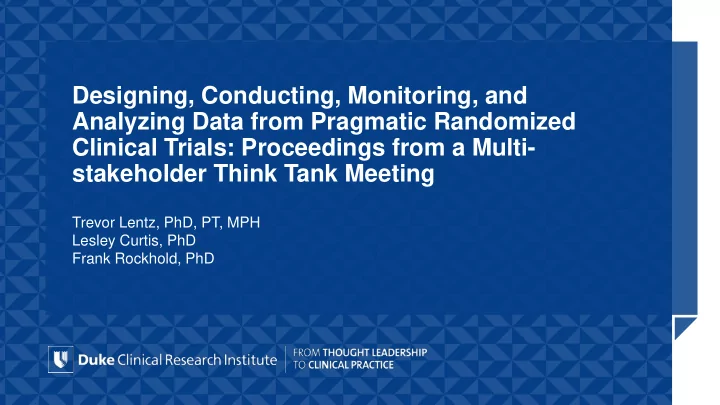

Designing, Conducting, Monitoring, and Analyzing Data from Pragmatic Randomized Clinical Trials: Proceedings from a Multi- stakeholder Think Tank Meeting Trevor Lentz, PhD, PT, MPH Lesley Curtis, PhD Frank Rockhold, PhD
Pragmatic Clinical Trials Randomized trials designed to inform clinical or policy decisions by determining the real-world effectiveness of an intervention Compared to other study designs that generate RWE – Use of randomization Compared to RCTs – Generalizable (i.e., clinical and policy/regulatory decision-making versus efficacy) – Clinical endpoints of interest to patients and clinicians versus surrogate RCT outcomes – Compare the intervention of interest to other active therapies in use
Study Design and Methodological Considerations “A properly designed PCT begins with a research question that is precise and clearly stated” “Study protocol adherence is necessary for any rigorous trial, and is consistent with the goals of a PCT”
Study Design and Methodological Considerations Pragmatism in study design is not a binary concept Purely explanatory elements Purely practical elements (created to establish efficacy (created to establish in idealized settings) effectiveness in the real world)
Reducing Bias Randomization, blinding, standardized outcome assessment, adjudication criteria, audits Example : Provider blinding may be infeasible or discouraged altogether in PCT designs • Could hinder ability to make therapeutic decisions and manage patients • Dearth of guidance in the literature on how to mask treatment allocation and whether it is even necessary in PCTs
Group (i.e., Cluster) Randomization Important considerations for group randomized trials: Balance of baseline covariates and group sample size through stratification or constraints in allocation Account for variance inflation due to correlations in outcomes within clusters – may require larger sample size
Informed Consent Waiver of consent Electronic consent – ADAPTABLE study
Best Practices for Data Quality and Completeness Data Provenance - Understand where data originate, as well as why and how data were collected Provides insights on their reliability and meaningful use for research and regulatory applications.
Best Practices for Data Quality and Completeness Embed streamlined Electronic Data Capture (EDC) modules with succinct eCRFs into the EHR so trial data are automatically collected – Potential to improve the cost and efficiency of PCTs – Requires early strategic agreements – Should begin with a minimal set of core data elements
Selecting Data Sources Select based on suitability to address specific questions A single data source may not be sufficient, hybrid data solutions may be necessary, which can involve linking EHR data, medical claims, PGHD, or other sources. Using hybrid data sources requires longer planning phases and more complex cost distributions than single-source collection.
Event verification Investigators may encounter situations in which they cannot confidently verify individual events, or two sources give different outcomes. – Example : EHR and administrative claims data Develop decision rules, or a hierarchy of what is considered closest to the truth, for resolving discrepancies by considering what is most accurate for individual data elements.
Best Practices for Data Quality and Completeness
Evolution in Study Monitoring Variability in data quality, gaps, and availability delays can hamper timely ascertainment of adverse events (AEs). Important implications for studies where safety is a primary endpoint (e.g. cardiovascular outcomes trial for a diabetes drug)
Risk-Based Monitoring The FDA encourages the development of centralized study monitoring plans that take advantage of modern clinical trial technologies and innovations. – Risk-based monitoring (RBM) - responding to predefined indicators of risk to patient safety, data integrity, or trial conduct and evaluating data trends that should trigger in-depth evaluation of trial activities
Risk-Based Monitoring Uncertainty surrounding the appropriate level of rigor for RBM and a poor collective sense of safety risks in PCTs limited the uptake of RBM and contribute to cautious monitoring and reporting. Collaborate with technology and data partners to develop and share adaptive learning strategies utilizing RWD sources. Human oversight of monitoring systems will remain a key component of PCT excellence.
Data Monitoring Committees and PCTs Will data be adequate and timely to allow the DMC to accept responsibility for safety monitoring? Oversee test runs of data extractions and/or linkages from all complex data streams involved to determine if these systems are adequate.
Data Monitoring Committees and PCTs Unique randomization schemes in PCTs also present challenges. Example : Cluster-randomized trials 1. How to manage inter-site differences in harms or benefits? 2. Does the estimate of intra-cluster correlation used in the trial design remains accurate to appropriately power the study? 3. How to manage site differences in reporting approaches?
Data Monitoring Committees and PCTs Experts in informatics, data science, and measurement Informatics scientist with expertise in devices that collect PGHD (i.e., wearables or mobile applications) (as applicable) Experts with knowledge in deriving novel biomarkers from continuous real-time monitoring devices (as applicable) Patient representatives
Recommend
More recommend